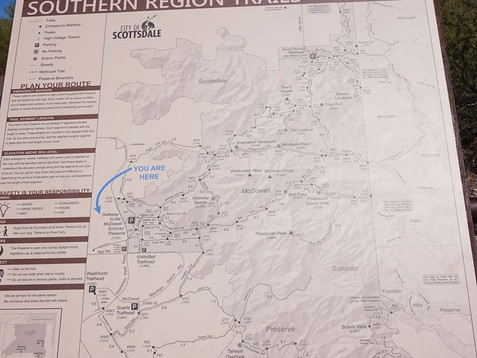McDowell Sonoran Preserve gateway and park designs demonstrates that innovative design, good craftsmanship, and local communities & nature oriented, reflect a dedication to respect the environment.
As part of the learning and inspiration process, one of the things we do is to visit local or overseas botanical garden or urban parks. Last October 2017, we had the opportunity to visit McDowell Sonoran Preserve. In these visits, we find a wide range of new ideas to bring into our forthcoming projects while reveling in the beauty around us.

Trail at the Entrance
McDowell Sonoran Preserve is located in the City of Scottsdale, Arizona. The area is about 30,500 acres or about 12,343 Ha, is a large, permanently protected, sustainable desert habitat. Nicknamed the “People’s Preserve”, the McDowell Sonoran Preserve is the direct result of citizen-driven and citizen–funded efforts to protect Scottsdale’s signature McDowell Mountains and the surrounding desert landscape. The preserve encompasses some 30,500 acres (123 km2) contiguously, and is the largest nature reserve in the United States.
Map at the Entrance

McDowell Sonoran Preserve
The preserve has over 180 miles (290 km) of trails. The trailhead gates are open from sunrise to sunset and there is no charge for access or parking. Popular activities include hiking (guided & self-guided), mountain biking, rock climbing, running, & horseback riding. In the Preserve, if the chances are good, you’ll spot a Saguaro (a tree-like cactus species in the monotypic genus Carnegiea that can grow to be over 12 meters tall. It is native to the Sonoran Desert in Arizona, the Mexican state of Sonora, and the Whipple Mountains and Imperial County areas of California), some wildflowers and local wildlife. The most frequently sighted desert animals include Gambel’s quail, jackrabbits, geckos and cactus wrens.
We at McDowell Sonoran Preserve
According to the local community and our references, the McDowell Sonoran Preserve Gateway site is designed so that the entry drive, parking and buildings integrate with the natural drainage patterns of the site. Retaining the pattern of native Arroyos throughout the site minimizes the necessary grading disturbances and allows for the Trailhead to be developed with minimal habitat impact. Parking areas and driveways are constructed with stabilized decomposed granite paving, which acts to retain the natural desert character and minimizing drainage run off. The rammed earth walls of the buildings utilize only native earth materials and allow the structures to blend seamlessly into the landscape.


The Gateway
The roof of the Gateway is covered in native desert rock cobble allowing it to disappear into the desert when viewed from the mountain trails to the east. The Gateway contains a range of educational and interpretive amenities including an outdoor amphitheater, a fully accessible interpretive trail, a 3D terrain model of the McDowell Mountains, and interpretive signage. Amenities are designed to enhance the visitor’s awareness of and appreciation for the Sonoran Desert environment. The Gateway itself illustrates how innovative design and a community committed to habitat preservation and sustainability can create a major trailhead while respecting the environment.














Comments